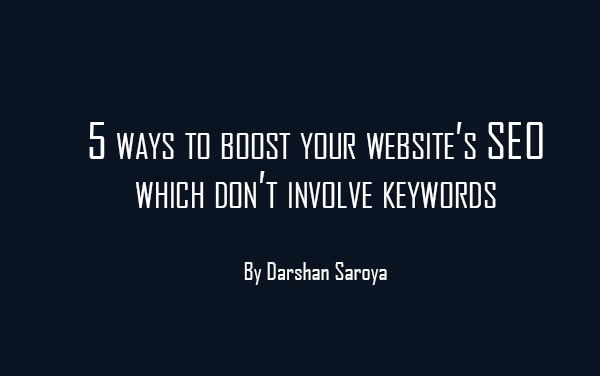What is the first thing that comes to mind when you think about trying to improve the SEO ranking of your website? We’re guessing you think about keywords, keywords, and keywords… and not much else.
While having keywords that search engines can pick up on as they crawl your website is important, it isn’t the be all and end all of SEO. There are many other factors that search engines consider when determining the ranking of your site.
Their algorithms will look at information such as the duration that visitors spend on your site, bounce rate, broken links, pages viewed and inbound and outbound likes, amongst others.
As you can see, getting users to stay on your website and like your content can offer a big boost to your search ranking. In effect, the more usable your website is to a visitor, the better chance you have of becoming more visible on Google, Bing, Yahoo, and the rest.
With that in mind, we’ve put together this list of five ways in which you can boost your website’s SEO, which doesn’t involve keywords.
Table of Contents
Regularly post useful and relevant content
‘Dwell time’ is the name given to how long a user spends on your website, and it can affect SEO ranking. If visitors spend a long time browsing your site, then search engines will assume they are staying there because the quality of the content must be high and that it, therefore, deserves to be placed higher up their ranking.
You can increase the number of time users spend on your site by posting useful and relevant content on a regular basis. An article or blog post in excess of 2,000 words that can draw and keep a user’s attention will increase the dwell time spent on your site and with it, your search ranking.
Longer content has other benefits, too. It gives you more opportunity to fit in outbound links, and these sorts of lengthy, useful articles will encourage more people to bookmark what you’ve posted as helpful information for the future. Should they bookmark it using Chrome as a browser, that can give a significant boost to your Google ranking.
Of course, writing long and engaging content may not be your forte. It isn’t many peoples really, which is why more and more businesses are either bringing content writers onboard as employees or paying freelancers to produce articles for their website.
This is certainly something worth considering as the ends will justify the means. You might think you don’t have the budget to pay freelance writers for their work, in which case taking out some form of loan or credit can allow you to do so. You can learn more about those options through Bonsai Finance.
Use header tags
While posting long articles is good for dwell time, at the same time being confronted by mountains of words on a page can be daunting and off-putting for readers. Nobody wants to see a post that looks longer than War and Peace, which is where header tags come in.
Using header tags breaks up your content into relevant sections, making it both easier to read and more pleasant on the eye. It will encourage visitors to stay on your site longer, increasing their dwell time.
They are also highly valued by search engines, who rate keywords placed in header tags more heavily. We know this article was focusing on ways to improve SEO which don’t involve keywords, but it’s important to note that they can add real worth when used in header tags – in fact, it is one of the best places to deploy them.
Include outbound links
By placing outbound links on your website, you’ll be adding further authority to what you are posting. You’ll also be making your own content and information more useful by broadening its depth – all of which is good news for SEO.
When Google detects a link from your site to a trusted and authoritative site elsewhere, it increases the relevancy of your content in the eyes of the search engine. It can also increase the dwell time a visitor spends on your site as if they click through to read more information from an outside source; then your website should remain upon in their browser while they do so.
Speed up your site loading time
Both Bing and Google take how quickly your site loads into account in their website ranking algorithms, but the importance of site speed spreads far beyond the opinions of the two major search engines.
53 percent of mobile browsing users abandon a site which takes over three seconds to load. For desktops, you get on average a whole one second longer in which to present your fully loaded site to a visitor before they decide they’ve had enough. Visitors clicking off before a page has loaded reduces your dwell time and increases your bounce rate.
There are many ways in which you can speed your site up in order to prevent visitors from leaving. Making sure your coding is clean and streamlined, optimizing the size of your images and reducing the number of plugins you are running can all help.
Remove any broken links as a matter of urgency
Broken links are bad news for usability as nobody wants to stay on a site where they are just being sent towards 404 pages. They’re also terrible news for your SEO ranking.
When a search engine comes across a site with a lot of broken links, it assumes that it is old and neglected. It certainly can’t be kept up to date as no rightminded webmaster would want their visitors to go through an experience where every other click is a broken link.
If going through your entire site to discover every single broken link sounds like far too arduous a task, then don’t worry as help is at hand. There are plenty of tools and apps that will scan your site for free, highlighting broken links and allowing you to fix them quickly. Some of the most popular include Screaming Frog, Google Webmaster Tool, and W3C Link Checker.








Leave Your Comment Here